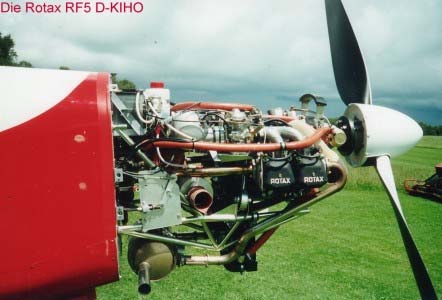RF5 Propulsé par un Rotax

Le bruit courrait depuis un moment qu´un inconnu du CFI allemand avait installé un Rotax sur son RF5. Nous l´avons cherché et finalement trouvé. Son nom : Armin Taffelt habitant en Bavière dont la particularité est qu´il est le premier propriétaire de son RF5 D-KIHO depuis 1969 avec le privilège de posséder une petite piste privée. Or les arbres en bout de sa piste, de seulement 300 mètres, poussaient de plus en plus haut si bien que le Limbach 2000 ne suffisait plus pour un décollage en toute tranquillité…

Devenu retraité, Armin a décidé en 1999 de remotoriser son RF 5 avec un Rotax 912-A et une hélice Hoffmann hydraulique HO-V352 F-S1 / pales S170FQ. Le suivi technique de la conversion a été fait par le Landesverband Bayern (ce qui correspond à la FNA de Bavière).
Le bâti-moteur, en berceau assez sophistiqué, a été construit par un atelier homologué LBA ce qui lui a coûté 5000 Euro. Le moteur est légèrement avancé pour permettre l´installation des récipients de refroidissement d´eau et huile. Tous les accessoires sont d´origine Rotax sauf le système d´échappement fait par Heggemann et adapté au RF5. Les capots ont été entièrement refaits. Ils sont un peu moins larges mais le capot inférieur a un ventre comme un SF 25 „Falke“ avec un gros trou circulaire pour l´aération des radiateurs situés sous le moteur. A première vue il aurait été possible d´installer le Rotax 10 cm plus haut et ceci aurait évité le ventre nécessaire pour cacher le radiateur et l´échappement. La forme typique des capots RF n´est plus reconnaissable, donc c´est une question de goût. On aime ou on n´aime pas !
Le KIHO vole avec un CDN provisoire depuis Septembre 2000 et a effectué à ce jour 62 heures. Armin indique 100 mètres pour le décollage, 190 km/h á 4800 tours/mn avec une consommation de 15 litres à l´heure. A 5600 tours ( plein gaz) le RF5 atteint 220 km/h. Le décollage simultané avec 2 autres RF5 a témoigné un taux de montée extraordinaire d´au moins 4 m/s. Le gros problème restera la certification. Il va sans dire que ceci prendra encore beaucoup de temps et coûtera quelques Euros … Armin est le propriétaire de la construction du bâti-moteur (homologué) des moules et des capots. Il s´agit là sûrement d´une innovation très intéressante car le Rotax 912 a fait ses preuves de robustesse et fiabilité, mais seulement à partir du moment où la conversion sera certifiée. Quant aux coûts Armin ne se prononce pas mais il faudra bien compter au moins 25.000 Euros !
Rotax Powered RF5
As the word spread that someone of the German CFI had installed a Rotax engine on his RF5, we snooped around and finally found him. His name is Armin Taffelt, living in Bavaria, whose particularity is that he is the original first owner of D-KIHO RF5 . He owns it since 1969, and has the privilege of having a small private runway. The trees at the end of his field, only 300 m „short“, kept growing taller and taller, to the point that the Limbach 2000 was no longer strong enough for an easy takeoff… When he retired in 1999, Armin decided to remotorize his RF 5 with a Rotax 912 TO and a Hoffmann hydraulic propeller with a HO-V352 F-S1 hub and S170FQ blades. The technical follow-up of the conversion was made by the Landesverband Bayern (what corresponds to the FNA of Bavaria).
The engine mount, a quite sophisticated cradle, was built by an LBA certified shop, and cost 5000 Euro. The motor is displaced slightly forward to allow room for the installation of the coolant and oil tanks. All accessories are Rotax’s original except for the exhaust system, which was made by Heggemann and adapted to the RF5. The cowling had to be entirely redone. It’s a little smaller but the lower half has a belly like a SF 25 “ Falke “ with a wide circular hole for the ventilation of the radiators, located under the engine. Apparently it would have been possible to install the Rotax 10 cm higher, and it would have avoided the belly to hide the radiator and exhaust. The typical shape of the RF5 cowling is no longer recognizable, therefore it’s a question of taste: Either you like it or you don’t!
D-KIHO flies with a temporary Airworthiness Certificate since September 2000 and has flown 62 hours to this day. Armin quotes 100 meters for the takeoff, 190 km/h at 4800 RPM with a consumption of 15 litres an hour. At 5600 RPM (full power), it reaches 220 km/h. A simultaneous takeoff with 2 other RF5’s proved an extraordinary rate of climb; at least 4 m/s. The biggest problem will remain the certification. It goes without saying that it will still take a lot of time, and will cost a few Euros… Armin is the owner of the certified motor mount structure , the molds, and the cowling design. It is indeed an interesting innovation, as the Rotax 912 has made quite a name for strength and reliability, but it will be feasible only from the moment the conversion is certified. As for the costs of the conversion, Armin’s isn’t saying, but it will be necessary to count with at least 25.000 Euros!

